The 50 worst players in Premier League history
Worst Premier League players
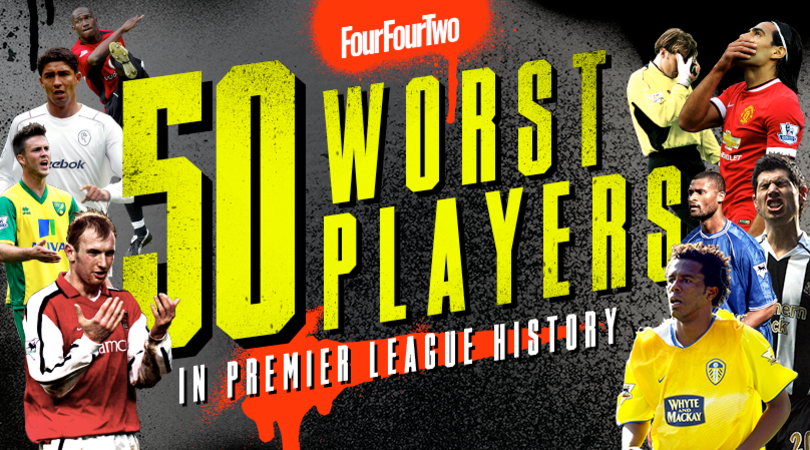
Worst Premier League players
An important note before we begin: we're not saying this lot couldn't play football. That they were rancid, useless, pathetic excuses for professional athletes. Well, maybe one or two – but often it's a case of bad timing.
Maybe it's a decent player out of his depth, or perhaps a once fine player debilitated by age or injuries. For whatever reason, however, the following 50 players didn't show their best form in the Premier League.
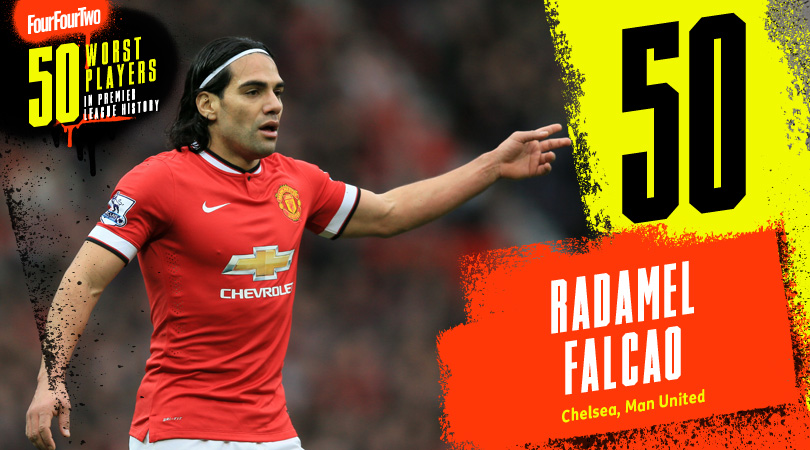
50. Radamel Falcao
The Premier League at its most ludicrously decadent. The Colombian striker’s loan spell at Manchester United cost the club around £4m per goal, while his time at Chelsea ran to somewhere in the region of £265,000 for every shot.
Obviously Falcao was – and has once again become – one of the continent’s finest forwards. But these were both terribly mistimed moves that ignored the realities of a serious knee injury and ultimately reduced a great player to a punchline.
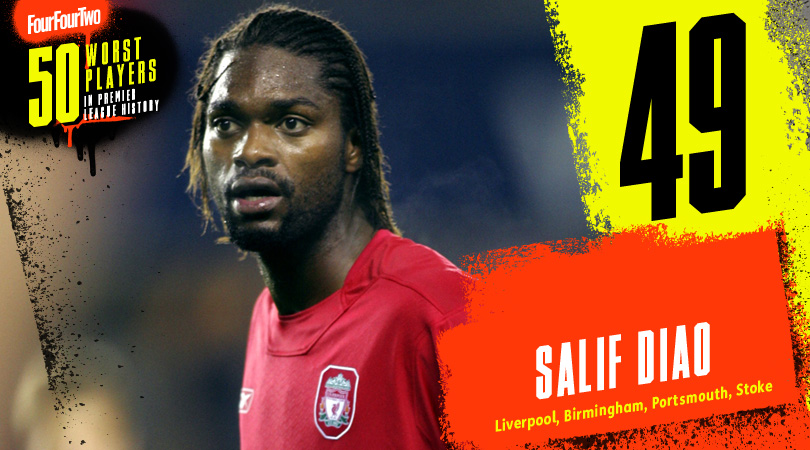
49. Salif Diao
Liverpool actually signed defensive midfielder Diao before the 2002 World Cup. So, after Senegal had been so impressive in Japan and South Korea, it looked as if they’d shopped very smartly indeed.
Not so. Diao was shuttled in and out of the side, often into unfamiliar positions, and seemed to become permanently destabilised by the lack of continuity. Not that he was really deserving of any extended opportunity, because much of what he did, he did far too slowly to ever be a credible Premier League midfielder.
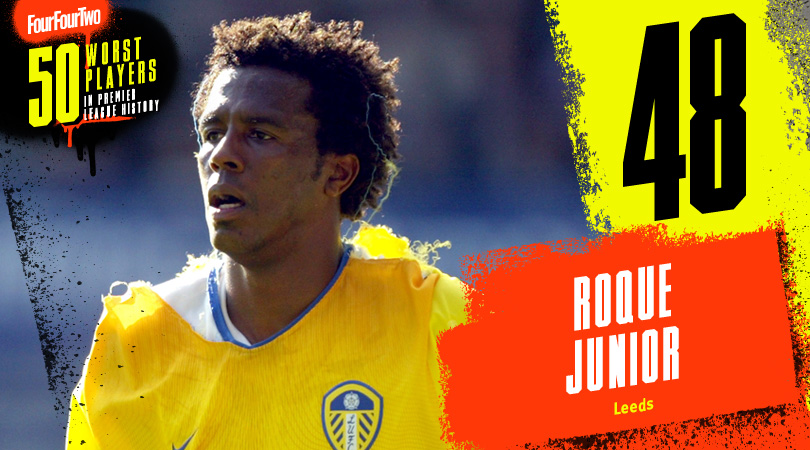
48. Roque Junior
There used to be a pejorative cliché about Brazilian defenders, long before Thiago Silva emerged to contradict it, and Roque Junior was a fine testament as to why.
He’d had a reasonable career in Serie A by the time he moved to Leeds on loan, but his stay in England quickly became a nightmare: he was sent off on his home debut and, notoriously, his run of games coincided with a succession of batterings for relegated Leeds. They haven't been in the Premier League since.
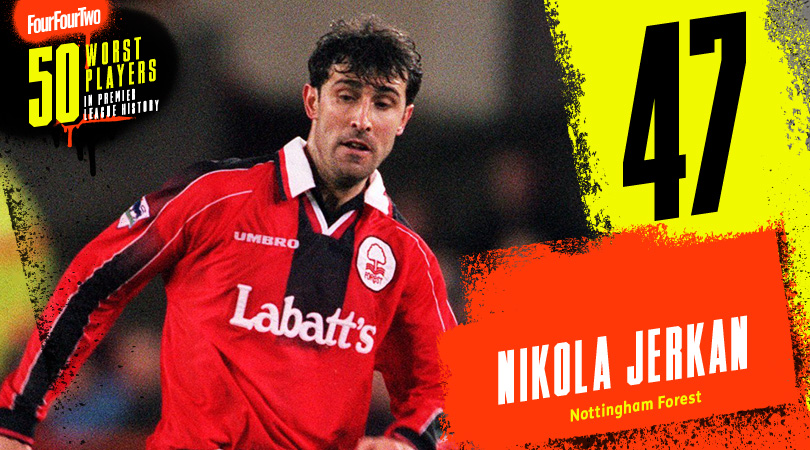
47. Nikola Jerkan
The only real explanation for Nottingham Forest signing Jerkan was the overall reputation of Croatian players at the time. That was a golden era – Davor Suker, Igor Stimac, Slaven Bilic, Robert Jarni, Zvonimir Coban – so Forest were presumably enraptured by the centre-back’s performances at Euro ’96.
Jerkan did perform well at the tournament, but there’s a reason why club scouts should be banned from international tournaments: they nearly always present a false economy. Reliably, Jerkan didn’t look anything like the same player in Forest red.
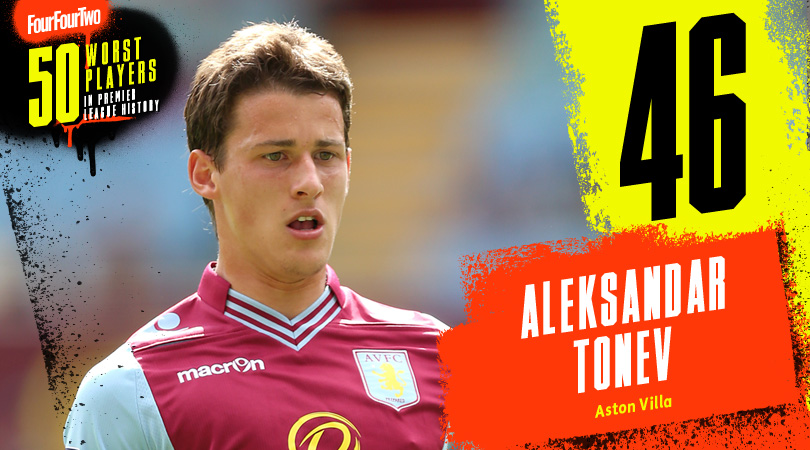
46. Aleksandar Tonev
There are actually still compilation videos on YouTube from Tonev’s Lech Poznan career. Watching them, it’s entirely understandable that Aston Villa were willing to take a chance on the Bulgarian in 2013. A delicate winger with a direct edge to his game and a goalscoring habit, he looked like an ideal signing for a struggling club on a budget.
But therein lies the fallacy of judging a player on video: it’s not what the footage shows, it’s what it doesn’t. Tonev wasn’t physical enough for English football and wasn’t quick enough to compensate for that fragility. Most worrying of all, he wasn’t particularly fond of his defensive duties either.
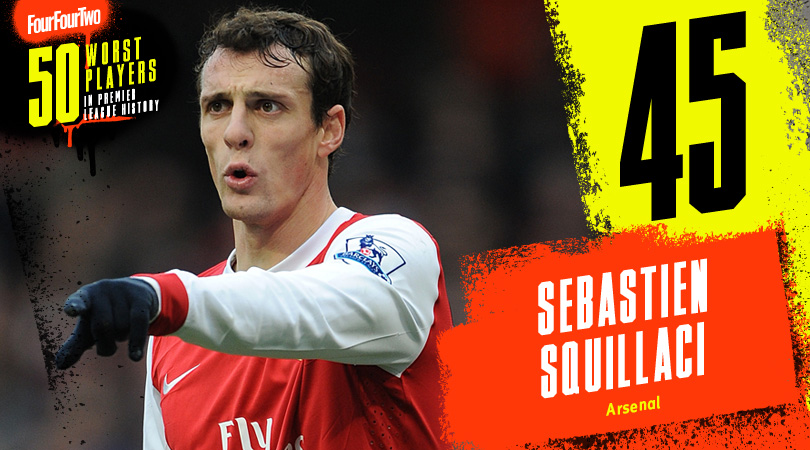
45. Sebastien Squillaci
‘Bad central defenders bought by Arsene Wenger’ might well deserve its own subcategory on this list. Squillaci was another transfer lunge, recruited in 2010 on the basis of a reasonable reputation forged at Sevilla.
Arsenal must have suspended their belief to convince themselves to make that £4m deal, though, because even the theory of Squillaci wasn’t particularly sound. The Frenchman didn’t possess any great pace, was neither aerially impressive nor equipped with the kind of finesse which would have made him a natural Wenger centre-back.
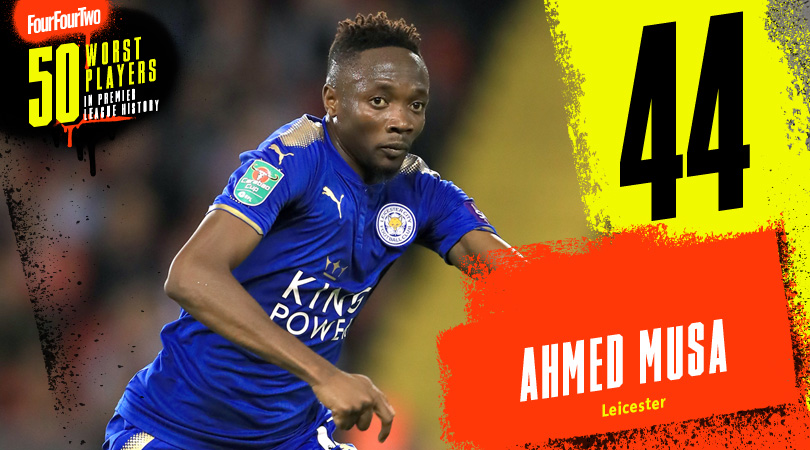
44. Ahmed Musa
In the glow of their Premier League-winning season, Leicester broke their transfer record to bring Musa to England for £16.6m from CSKA Moscow.
The Nigerian forward has always been an unremarkable and patchy player who, most importantly, didn’t have a natural place in the Foxes side. At no point in his 18 months at the King Power Stadium (33 games, five goals) did Musa’s transfer ever look likely to be remotely successful.
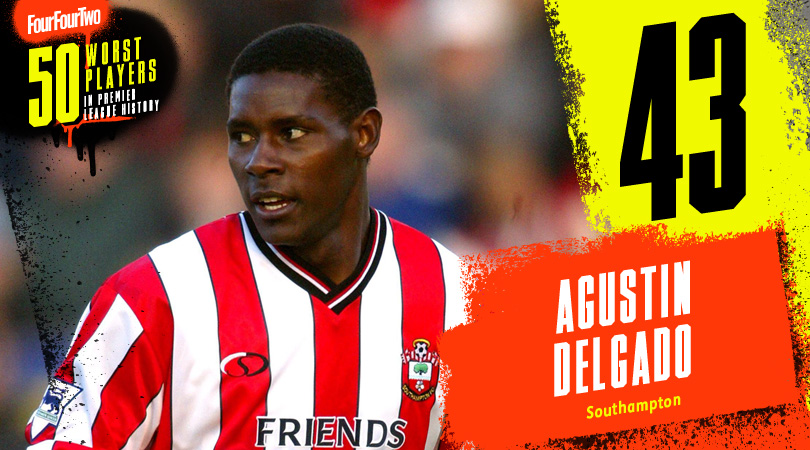
43. Agustin Delgado
An asterisk to this one: the limp, ineffective forward who English fans vaguely remember wasn’t really Delgado. This was a damaged player who suffered terribly with injury and, frankly, it’s a wonder he passed a medical when signing in 2001.
His fitness issues also led to a fractious relationship with Gordon Strachan. “I've got a yoghurt to finish by today; the expiry date is today. That can be my priority rather than Agustin Delgado,” the then-Saints manager once announced.
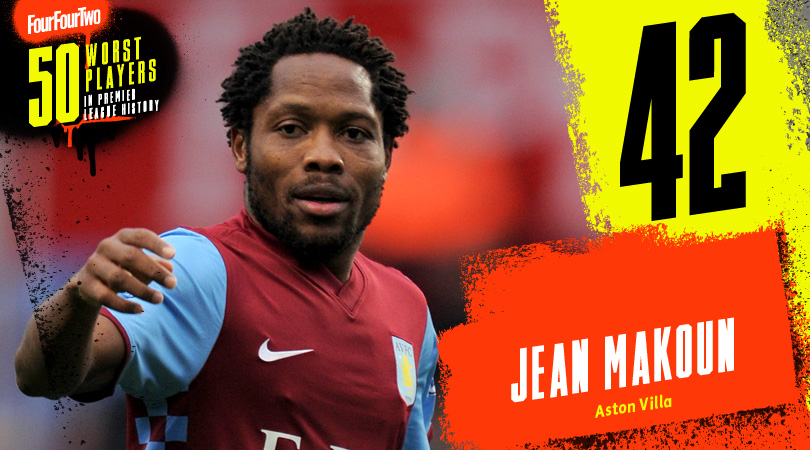
42. Jean Makoun
Far better in Football Manager than he ever was in real life, Cameroon midfielder Makoun arrived at in 2011 Villa Park on the say-so of Gerard Houllier in 2011.
Strange as it is to say, the reaction to his meagre efforts was probably multiplied by his digital reputation. Villa were becoming a terrible mess at the time and, at £6m from Lyon, Makoun was presented as something of coup. After nine Premier League appearances, that was shown to be definitively not the case.
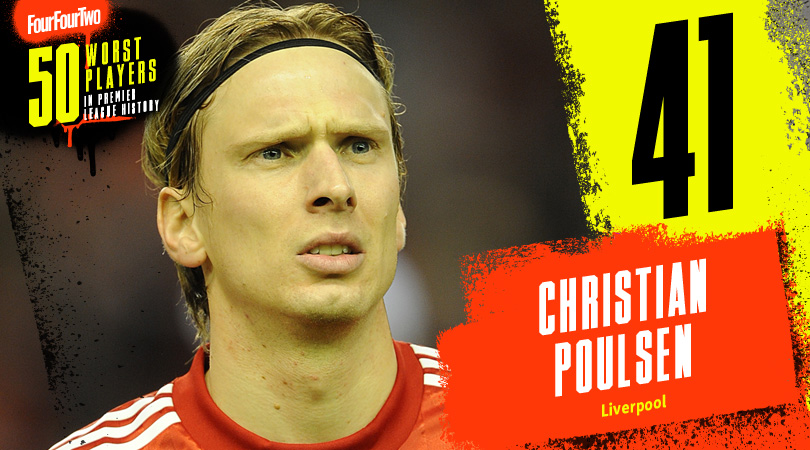
41. Christian Poulsen
Poulsen was damned for his association with Roy Hodgson’s miserable stint as Liverpool manager, as much as anything else. The Danish midfielder had had a strange career, flaming out at Schalke before being caught in Monchi’s net at Sevilla, then performing well enough to earn a move to Juventus in 2008.
Yet his transfer to Anfield (for £4.5m in 2010) came after his 30th birthday and time had evidently caught up with him, diminishing his formerly combative style. The game was too quick for him and, once Hodgson had been sacked, Kenny Dalglish wasted little time in marginalising him from the first team.
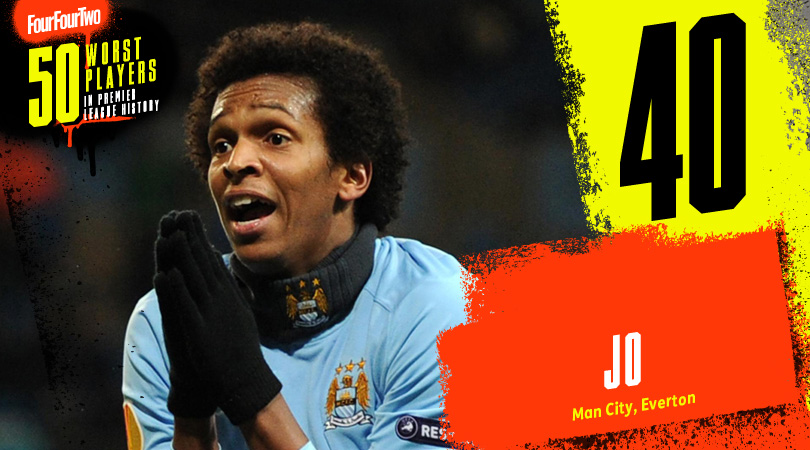
40. Jo
Brazilian forward Jo was Manchester City’s record signing before Robinho, arriving for £19m two months prior to his compatriot in 2008.
Jo was a victim of circumstance at City, signed immediately before the sudden dawn of the Sheikh Mansour era, then supplanted within weeks by a far glitzier signing. Yet that doesn’t fully explain his shambolic level of performance, nor how it remained that way once he’d been shipped off to Everton on loan.
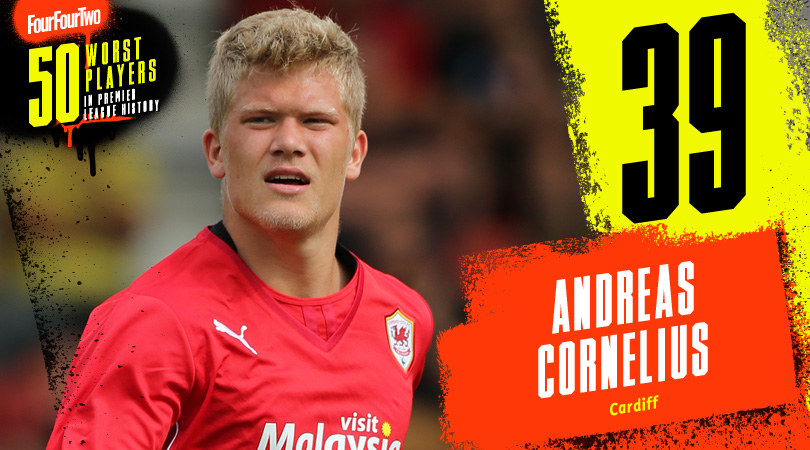
39. Andreas Cornelius
Whenever a club breaks their transfer record to sign a striker, you imagine there’s a fair few fingers crossed in the boardroom. The bigger the signing, the sillier you can end up looking.
It’s a lesson that was learned the hard way at Cardiff, when the Welsh club parted with £8m or so after manager Malky Mackay identified Cornelius as a striker who knew where the goal was. As it turned out, he barely knew where the pitch was. His Cardiff career consisted of eight appearances, zero starts, zero goals, and one cut-price move back to Denmark after six months.
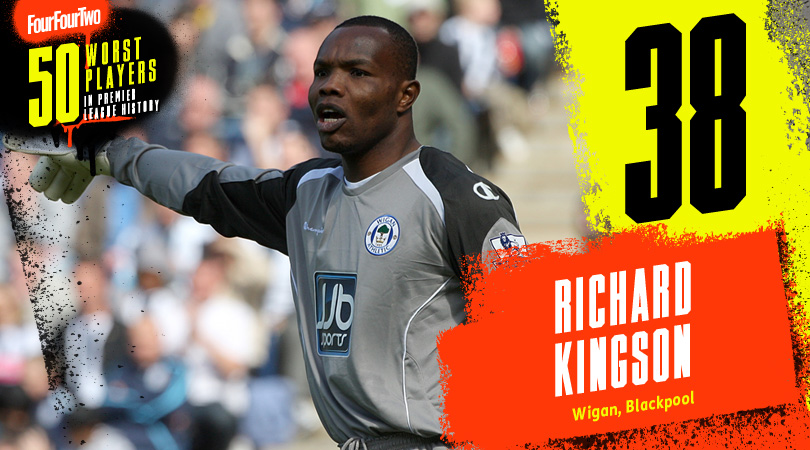
38. Richard Kingson
Kingson made his Wigan debut as a substitute and soon saved a penalty against West Brom, but it was all downhill from there. And downhill immediately: Chris Brunt knocked in the rebound off that spot-kick, Wigan lost 3-1 and Kingson played three more top-flight games for the club – all defeats.
Not great, although there was rather more fun to be had in his subsequent season with Blackpool; he played 20 games, conceded 38 goals and contributed to historic wins over Liverpool and Spurs. Sure, it all ended with a relegation and Kingson being released at the end of the season, but it’s the journey that counts, right?
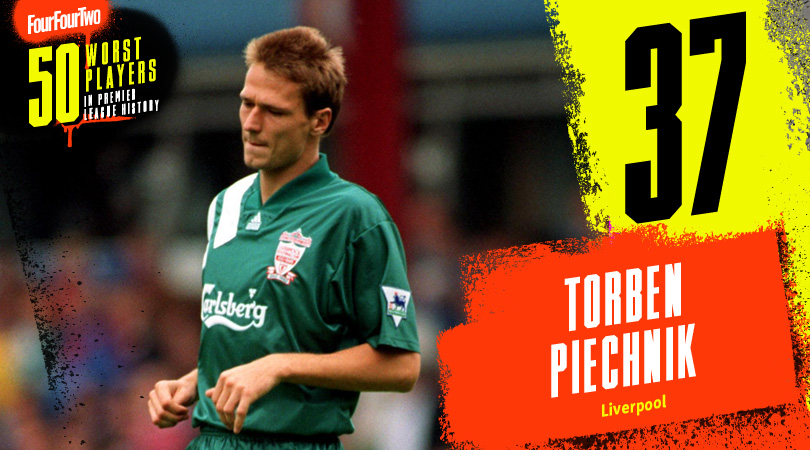
37. Torben Piechnik
Liverpool’s Graeme Souness era is remembered with little fondness on Merseyside. History has come to recall all this through the prism of the Scot’s horde of terrible signings, and towards the top of that list is Piechnik.
The defender was acquired in the wake of Denmark’s triumphant Euro ’92 campaign, to which he contributed a decent performance and a half in the latter stages. After a quietly encouraging start, Piechnik’s form fell off a cliff and he was packed back off to Denmark after two inauspicious years.
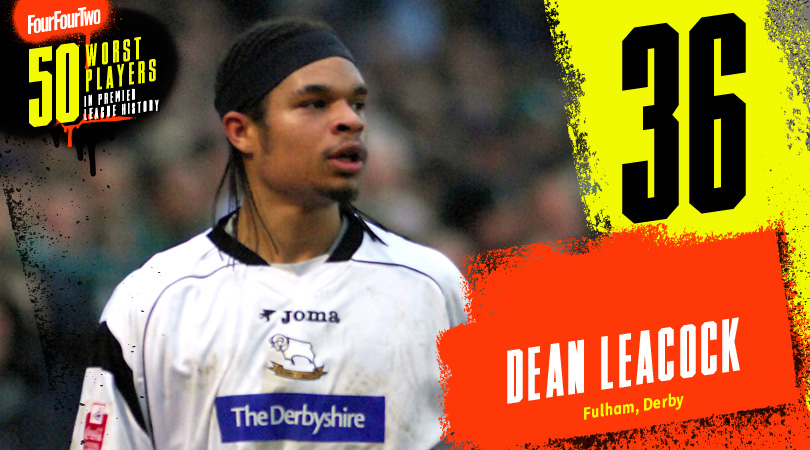
36. Dean Leacock
Leacock is that rare treat of a footballer: a one-time top-flight pro who’s embarked on a devoted career of whistle-stop lower-league journeymanship. Now 35, the centre-back was most recently kicking a ball for Lowestoft Town of the Isthmian League, yet in his Premier League heyday it was Derby and Fulham.
There’s plenty to love about a player willing to trek to even the most windswept outpost in his thirst to simply play football – and given that he was a member of that Derby side of 2007/08 (11 points from 38 games), no one can say he hasn’t earned it.
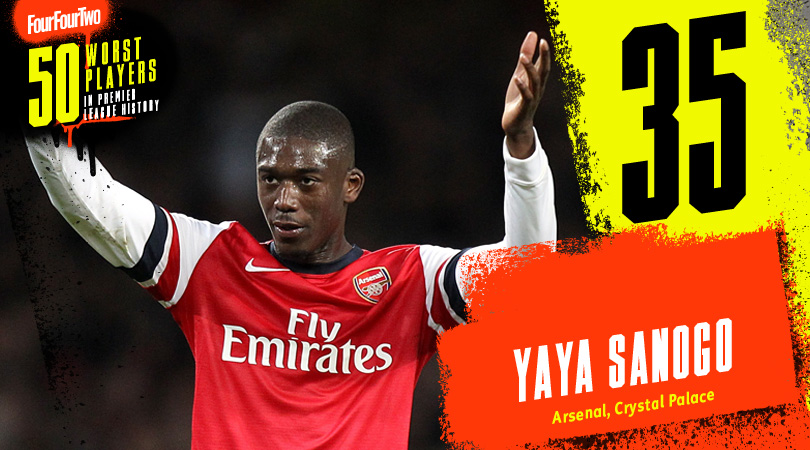
35. Yaya Sanogo
In January 2018, Sanogo scored his first top-flight league goal. Unfortunately for Arsenal, it didn’t come for them, nor even within four years of signing for them as a promisingly muscular young striker who looked set to hit the big time at Auxerre.
His promise-turned-bumbling-ineptitude was late-Wenger era Arsenal in a nutshell, and neither a loan spell in the cultured surrounds of Ajax nor the rough and tumble of Selhurst Park could prompt a return to that heady early trajectory.
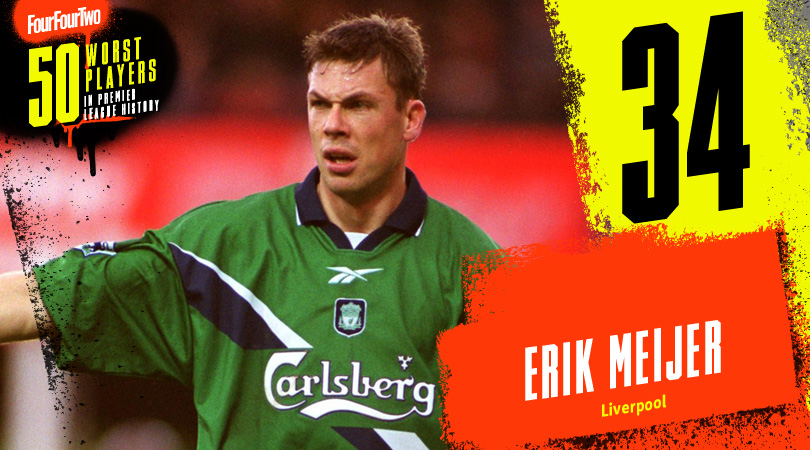
34. Erik Meijer
Football fans can occasionally be a forgiving lot, and for many players limited ability need not mean limited popularity. Never has this been truer than in the case of Erik “He’s big, he’s red, he’s off his f*****g head” Meijer, signed by an upwardly mobile Liverpool in 1999.
The Dutchman provided an unquenchable thirst to chase lost causes, and the unsettling habit of bellowing at his team-mates for reasons good, bad and unclear. “Mad Erik” became a cult hero on the Kop, never scored a league goal in his Liverpool career and departed after a year, replaced by the infinitely more prolific Emile Heskey.
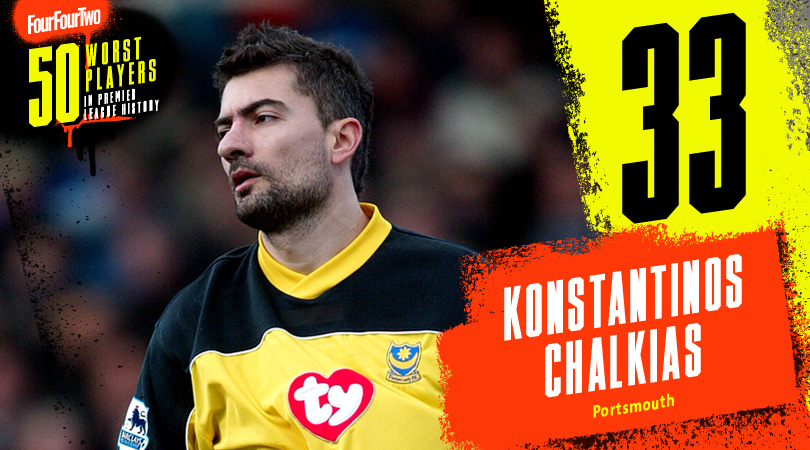
33. Konstantinos Chalkias
For a goalkeeper, it’s not a great look when your performances have your manager dipping into his pocket to sign Sander Westerveld in a bid to instate some level-headedness to the position.
Unfortunately for Chalkias, that’s exactly what happened during his brief stint at Portsmouth in the mid-noughties, signed presumably in the hope that he might bring his lucky charm from Greece’s underdog triumph at Euro 2004 to the south coast. It didn’t quite work out that way: five appearances, four defeats and 11 goals conceded saw him lose his place to Jamie Ashdown.
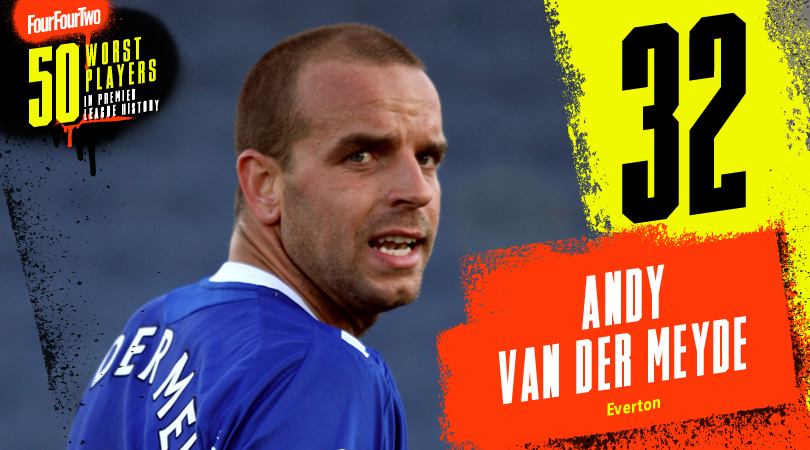
32. Andy van der Meyde
Twice a Double winner with Ajax and a winger who'd played alongside the likes of Juan Sebastian Veron, Edgar Davids and Christian Vieri at Inter; many an Everton fan thought they'd landed a superstar when the Dutchman signed in 2005.
Instead, injury troubles hobbled Van der Meyde from the off. During his lengthy absences, addiction, mental health struggles and turmoil in his family life formed a perfect storm of discontent. A visibly out-of-shape player only ever made 20 appearances for Everton across four seasons.
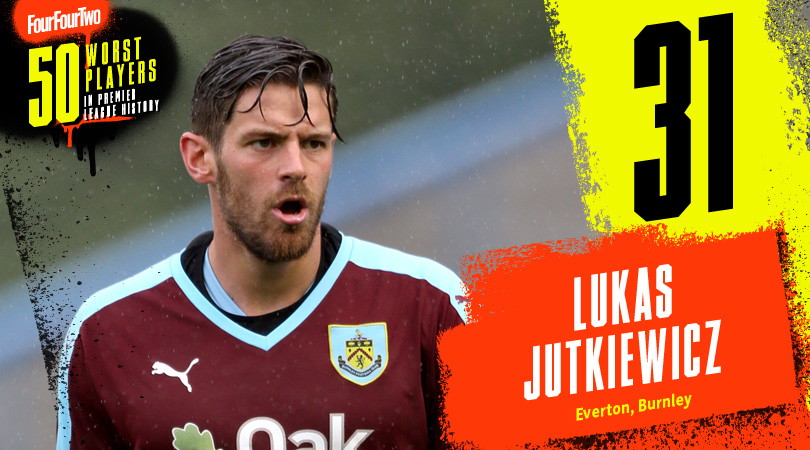
31. Lukas Jutkiewicz
Jutkiewitz only played four Premier League minutes during a two-year stint at Everton, but that they bore zero goals was a sneak preview of what was to come. Half a decade later, the beefy striker reappeared in England top flight, this time with Sean Dyche's Burnley, a side whose rough-and-ready blueprint would surely play to the English forward’s strengths.
Quite what those strengths were never became truly clear. Over a 25-game season, ball was never once introduced to net.
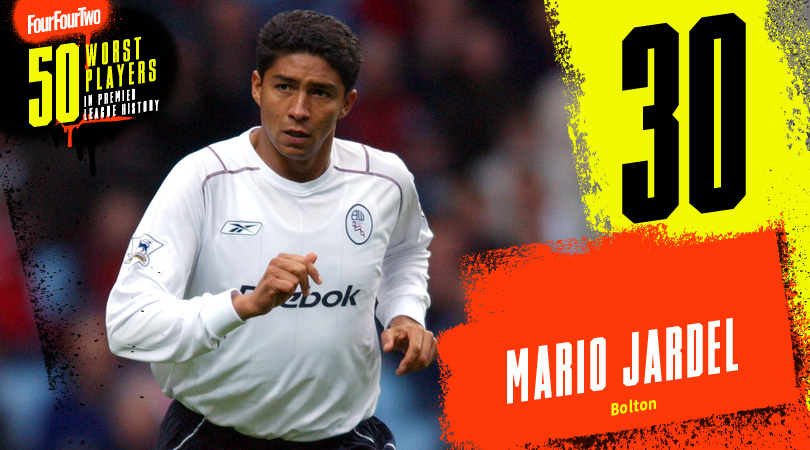
30. Mario Jardel
The late ’90s was a time before blanket television coverage of the European game, so most of Jardel’s scoring feats occurred in the dark, but in four of his six Primeira Liga seasons he averaged a goal per game or more. To English supporters he’s a standing joke, but back in Portugal the Brazilian remains immortal.
The Porto hero was similarly prolific in Turkish football with Galatasaray. Then, just short of his 30th birthday in 2003, he became another unlikely addition to the Sam Allardyce movement at Bolton. That’s when the fun stopped: seven Premier League appearances and nothing but a couple of cup goals, a lack of mobility and a mighty waistline to show for it.
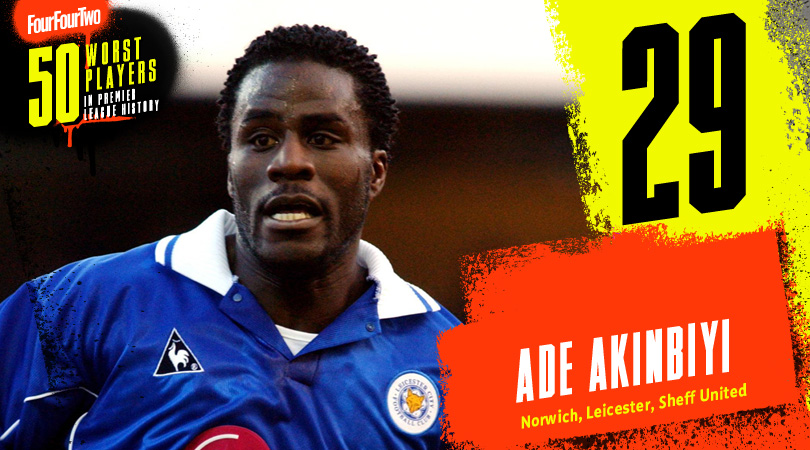
29. Ade Akinbiyi
Yes, we admit it: this has plenty to do with that game for Leicester against Liverpool. Some 20 years later, it’s still hard to watch: the wild shanks, the miscued headers, his sad little face.
It would be remiss not to point out that Akinbiyi had a thoroughly respectable career outside the Premier League. Burnley, Wolves and Bristol City fans will all remember him fondly(ish), but the memory of that day at Filbert Street is just too vivid. Top-tier spells either side of his two seasons at the Leicester – at Norwich and Sheffield United – yielded no goals in 18 appearances.
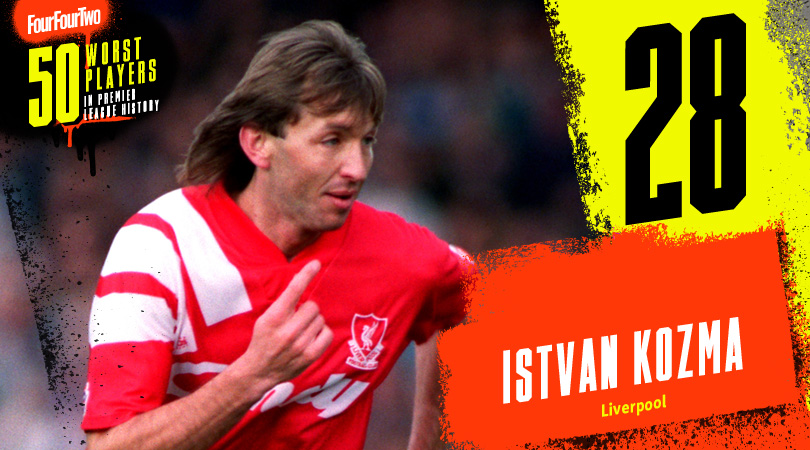
28. Istvan Kozma
The mistake Graeme Souness made as Liverpool manager was trying to change too much, too soon. There’s no more vivid symbol of that and of Liverpool’s demise at the time than Kozma, the Hungarian signed on the basis of his displays for Dunfermline.
At first glance, Kozma was a passable winger. He owned some pace and had a few stepovers in his locker. The trouble, as with many others on this list, was that English football was still a rugged environment in the early 1990s and Kozma - despite his time in Scotland - didn’t have much appetite for that style of play.
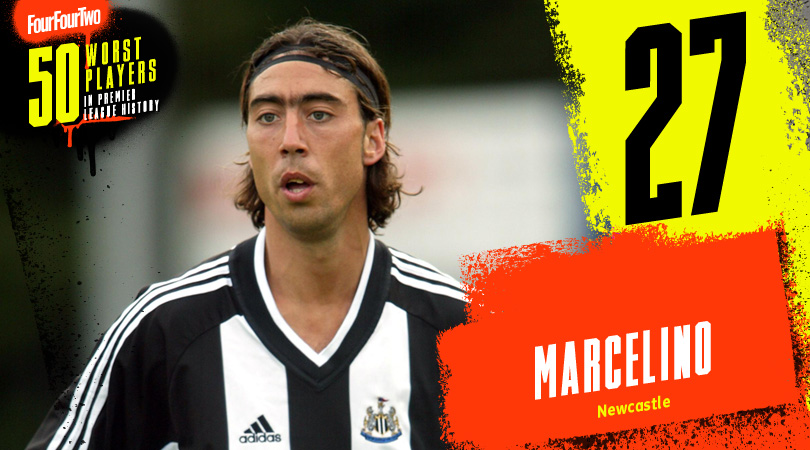
27. Marcelino
Marcelino had been a big part of Mallorca’s late-90s resurgence before being signed by Ruud Gullit in 1999 (for all of £5.8m), and there was no reason to believe he would one day end up on a list like this.
The facts surrounding his time at the club remain unclear. Depending on who you ask, he was either a layabout permacrock who would do anything to avoid actually playing, or a prisoner to his own contract whose career was sabotaged from within the organisation itself. Whatever the truth, the 17 calamitous Premier League appearances he made over four years virtually ended the Spaniard’s international career and damaged his reputation permanently.
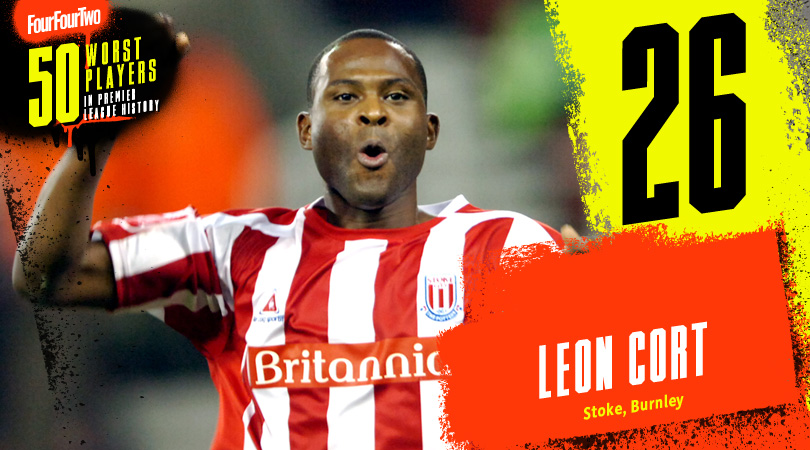
26. Leon Cort
In 2017, FourFourTwo asked supporters of every English league outfit to vote for their worst ever player. Cort’s entry, for Burnley, is worth a re-airing: “Lacking mobility to the extent of looking like Bambi’s slow cousin on ice.”
The English defender also played for Stoke, Crystal Palace and Hull, and compliments are hard to find – although he did win the Player of the Year award at Selhurst Park in 2006/07. Cort's best days came at Southend, which perhaps indicates he was over-promoted during his Premier League days.
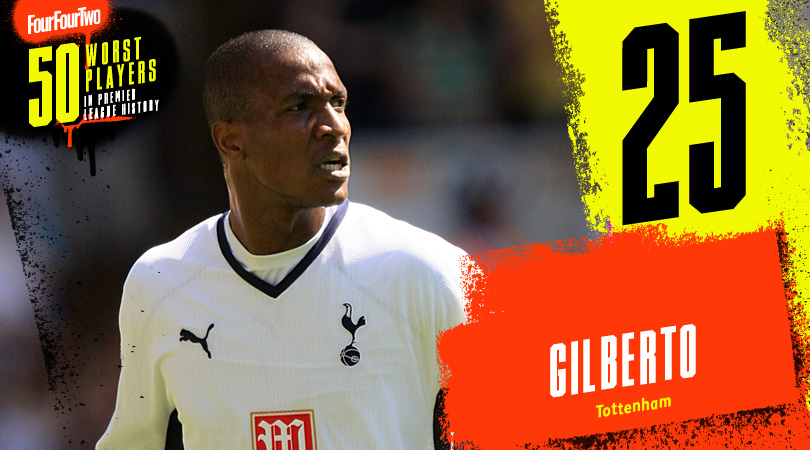
25. Gilberto
Gilberto was signed by Tottenham on the final day of the January 2008 window from Hertha Berlin and was representative of all the bad transfer habits the club had developed. The left-sided Brazilian never really had a definitive purpose at Spurs – other than becoming a target for supporter dissatisfaction during Juande Ramos’s increasingly chaotic time at the club.
Naturally, Harry Redknapp took one look at Gilberto and decided he wasn’t fit even for Europa League purposes. As far as anyone is aware, he was substituted at half-time against Shakhtar Donetsk and then immediately put into a taxi, disappearing into the north London night.
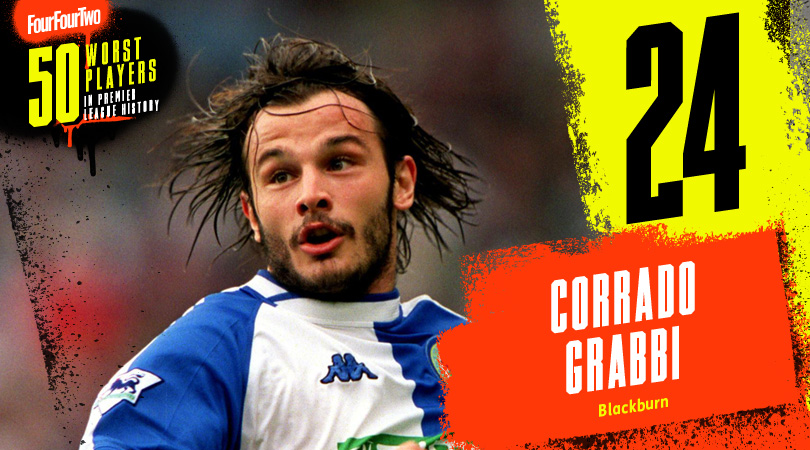
24. Corrado Grabbi
A prolific run of form at Ternana, where Grabbi scored 20 goals in 34 games, was enough for Blackburn to spend £6.75m on his signature. It wasn’t a good fit. Alongside the normal complaints about the British weather, Grabbi would later claim he was ostracised by many of his team-mates.
Two goals in 30 league games suggests such unease bled into his form, but more likely this was a case of flawed scouting. Blackburn evidently saw a player at the peak of his form and signed him without considering whether it was reflective of his ability.
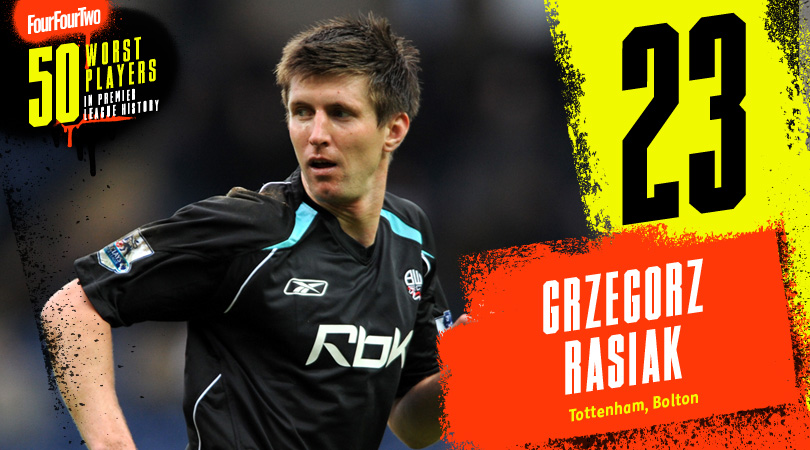
23. Grzegorz Rasiak
There’s definitely something David Nugent-esque about Rasiak’s career. The Polish striker wasn’t quite as prolific in the Football League, but he was very clearly not good enough to play at the highest level. As Tottenham quickly found out when they signed him in 2005.
Even then, before the club’s renaissance had truly begun, he was way short of being the player the supporters wanted him to be. Rasiak worked hard, but the all-round package he represented - size and strength - never looked remarkable away from Derby. He made just eight Premier League appearances before departing.
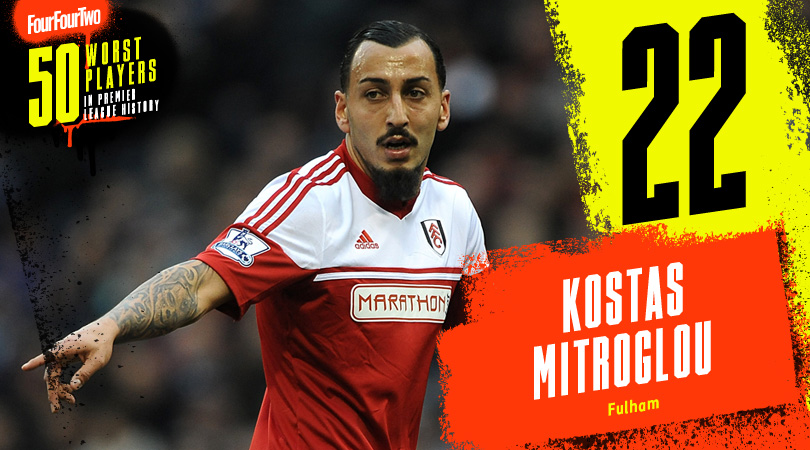
22. Kostas Mitroglou
Fulham lunged after a goalscorer in the January 2014 transfer window, spent a club-record £12.4m on the Greek striker, and expected an instant dividend on a player with no experience in this country.
What they got was three instantly forgettable appearances, two of them from the substitutes’ bench. It’s the only spell of Mitroglou’s career which hasn’t been successful – he’s provided a steady flow of goals for the likes of Benfica and Olympiacos since – meaning this costly failure is probably more on the club’s shoulders than his.
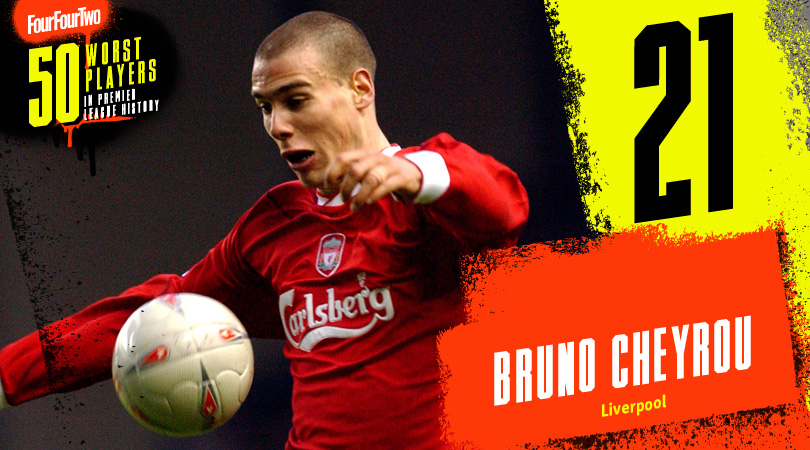
21. Bruno Cheyrou
One of the advantages of Gerard Houllier’s appointment was his inside knowledge as a technical director of the French Football Federation. Cheyrou, signed in 2002 for £4.5m, was lumbered with the title of the “new Zidane” by his new boss. Not quite.
The midfielder struggled during his first season and although he actually scored one or two important goals for the club (his first league strike was in a 1-0 win over Chelsea), but he's also emblematic of Liverpool’s wayward transfer dealings. Cheyrou wasn’t quite Sean Dundee, but it was telling that he was loaned out the moment Rafael Benitez took charge.
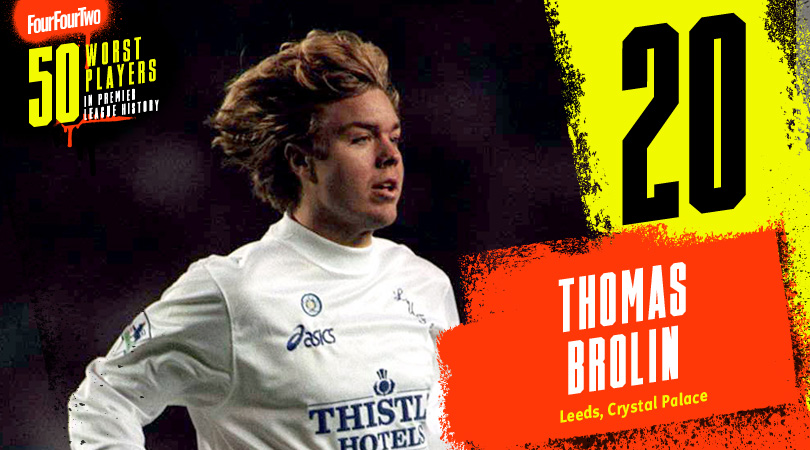
20. Tomas Brolin
Brolin was – was – brilliant. Anyone who caught Parma on Football Italia will know that; so too those old enough to remember Euro ’92 or the 1994 World Cup. An excellent finisher and good in the air despite his size, the transfer to Leeds made sense at the time.
In hindsight, manager Howard Wilkinson might have wanted to look deeper. An injury disrupted Brolin’s Serie A career and, before being sold, he never regained his form, fitness or ultimately his place in the side. The player who arrived at Leeds - overweight, lazy, apathetic towards defensive responsibility - was already a pale imitation of what had come before.
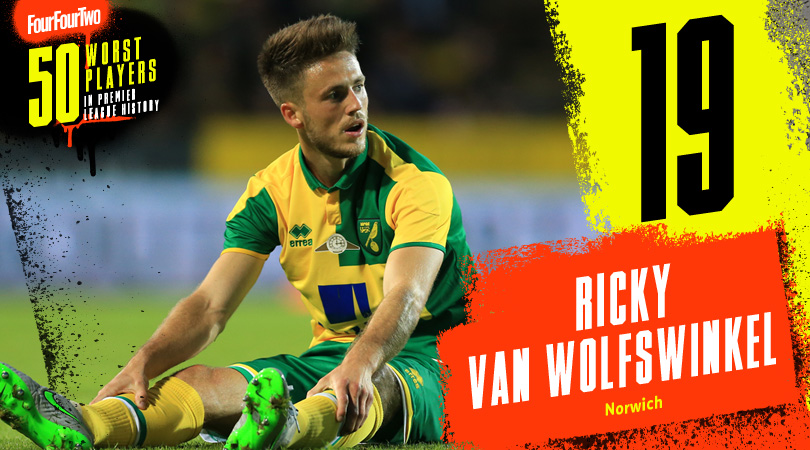
19. Ricky van Wolfswinkel
Van Wolfswinkel actually netted on his Norwich debut in 2013 which, at the time, seemed to indicate that the fine form he’d shown in the Eredivisie and the Primeira Liga could be reproduced in England. In fact, the £8.5m Dutch striker would never score another goal in 24 further Premier League matches.
Maybe the most obvious point to make about him concerned his body shape; he just didn’t look like a player suited to British football. Neat enough on the ball but frail and willowy, he had natural red flags which Norwich would have done well to recognise.
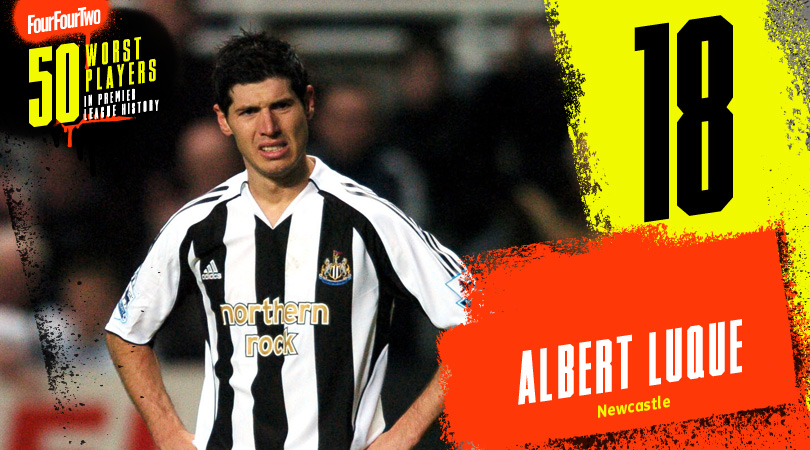
18. Albert Luque
Quick, skilful and the embodiment of all sorts of pleasing Iberian clichés, the Spain international was a highly capable player who had scored some stunning goals for Deportivo La Coruna. Watch his bicycle kick if you haven’t seen it.
To this day, it’s difficult to know why it went so badly wrong. The fee was large (£9m back in 2005) and Newcastle, still struggling to recapture what had been lost, wasn’t the easiest club to play for. But Luque appeared to lose all his self-belief on the flight over and left little impression at all on the Premier League.
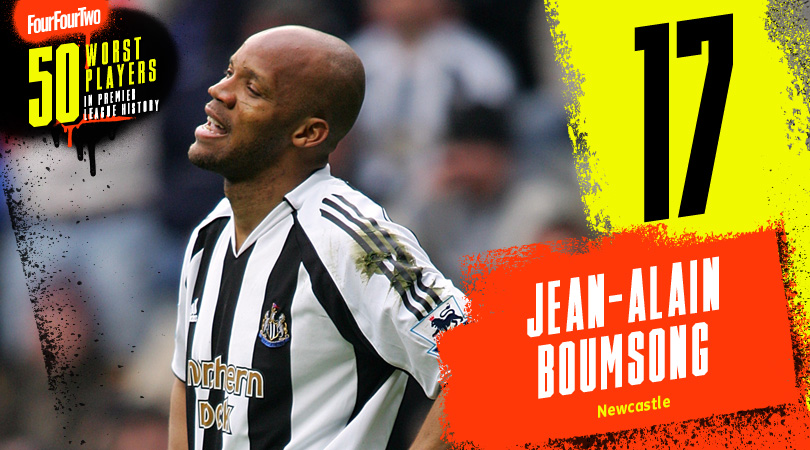
17. Jean-Alain Boumsong
Boumsong was an example of a player who couldn’t cope with the Premier League. Signed in 2005 on the basis of an impressive but brief spell at Rangers - and for a significant £8m - a strong initial impression at Newcastle descended into a slew of problems, red cards and costly miscalculations.
The own goal against Middlesbrough, the forlorn expression after being sent off against Liverpool; these are moments which make an iron-clad comedic legacy for a defender. Juventus would eventually rescue him from England and the Frenchman’s career did recover, but the Premier League was a stage he should never have been on.
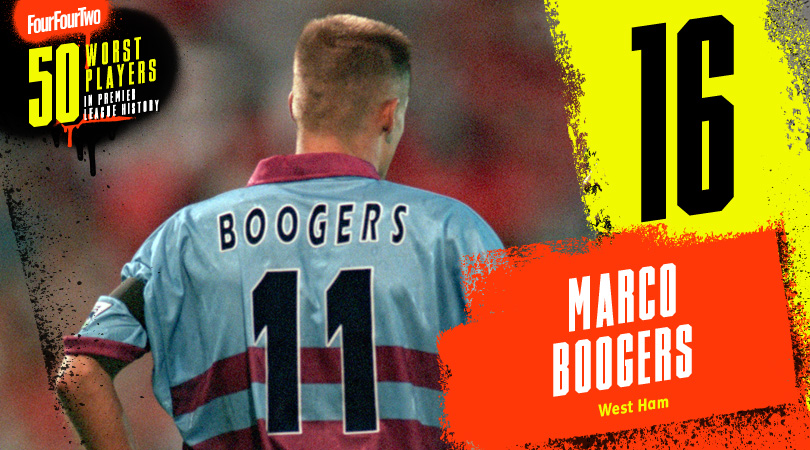
16. Marco Boogers
The story that Boogers fled east London to live on a caravan site isn’t true. However, this was a time when West Ham were willing to roll the dice in search of their next great forward, and a £1m offer was made to Sparta Rotterdam without manager Harry Redknapp ever having seen him play.
The only impression Boogers left on English football was felt by Gary Neville, who was halved by the Dutchman’s wild challenge at Upton Park. It was a clear red in the 1990s; now it might lead to a custodial sentence. Following his suspension, circumstances conspired against him: a knee injury worsened and Boogers soon returned to the Netherlands.
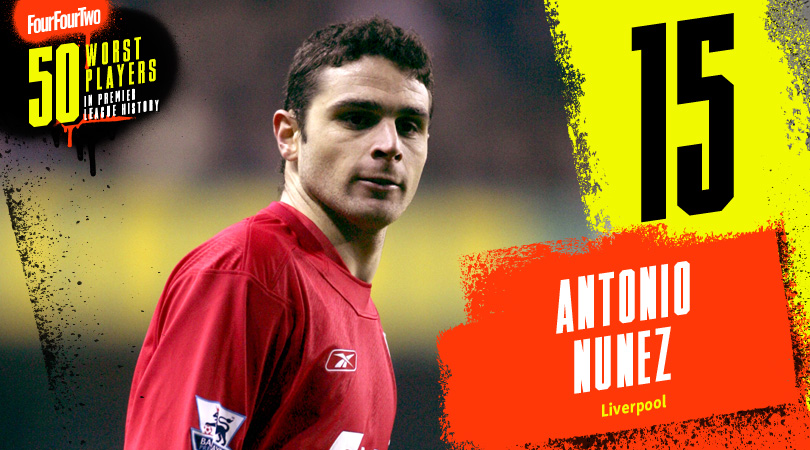
15. Antonio Nunez
Nunez arrived at Liverpool from Real Madrid as part of the deal which took Michael Owen to the Spanish capital in 2004. The winger set the tone for things to come by getting injured on day one of training and missing the first three months of the season (a perfect replacement for Owen, you might say).
Nunez managed 27 appearances in his solitary season at Anfield, despite a reputation for sending crosses into the stands, and remarkably came away with a Champions League winner’s medal before leaving to join Celta Vigo.
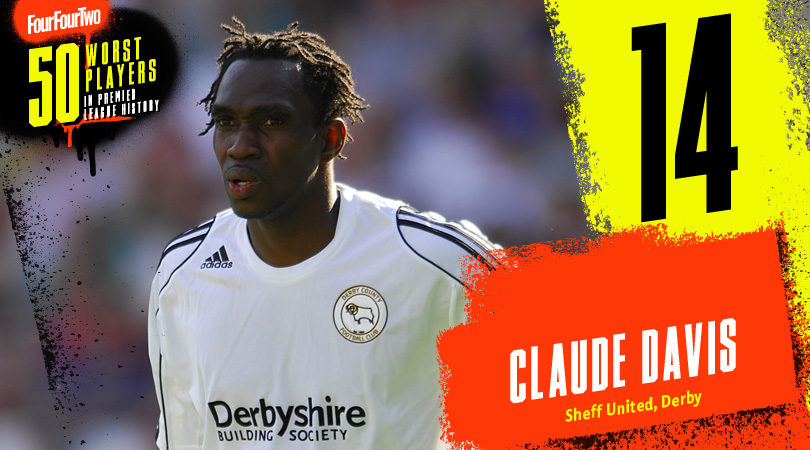
14. Claude Davis
When Derby were promoted to the Premier League in 2007, manager Billy Davies sought to strengthen the defence for the rigours of top-flight football. He spent £3m on centre-back Claude Davis, who had played under him at Preston North End.
Yet Davis proved wholly unsuited to Premier League football. He played just 19 times as the Rams slumped to a record low points total of 11, while earning himself the nickname 'Calamity Claude'.
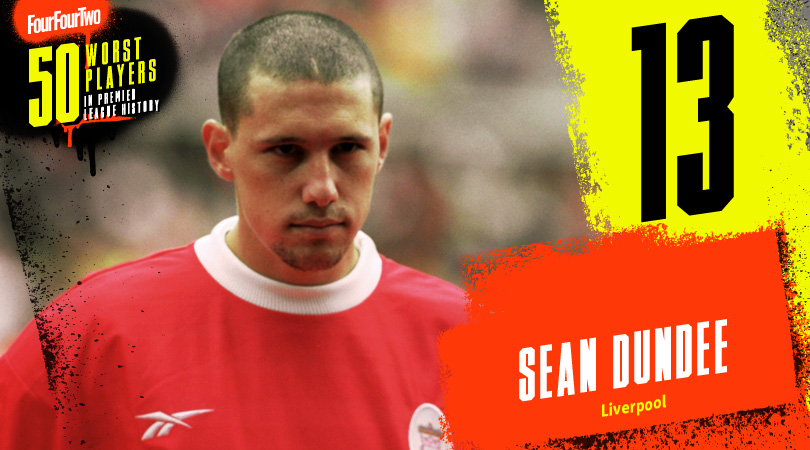
13. Sean Dundee
The South African striker joined Liverpool in 1998 with a healthy record in the Bundesliga. Dundee was supposed to provide cover for the injured Robbie Fowler; as it turned out, the Reds had signed another dud – one in a long line of strikers who failed to cut it in front of the Kop. Almost mesmerically slow, he made just five first-team appearances and failed to score.
"One player I do regret signing was Sean Dundee,” said Roy Evans later. "He was terrible on and off the pitch. He didn't take any notice of me, did what he wanted and lacked discipline. He certainly shouldn't have joined Liverpool."
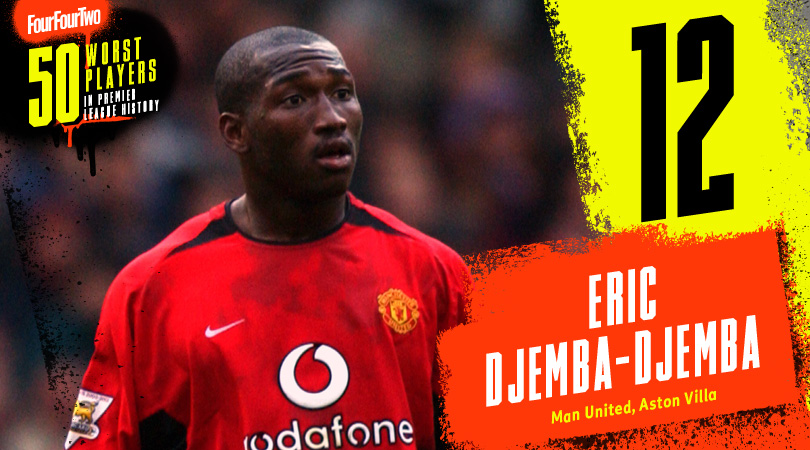
12. Eric Djemba-Djemba
Alex Ferguson made a number of bizarre signings in the years after winning the Treble, with midfielder Djemba-Djemba sitting high on the list. The Cameroon international was plucked from Nantes in 2003 and earmarked as a potential successor to Roy Keane.
While he certainly had the unchecked aggression, he had little of the Irishman’s passing ability. Djemba-Djemba spent 18 months being largely awful at Old Trafford, didn’t do any better at Aston Villa and is now playing in the Swiss fifth division.
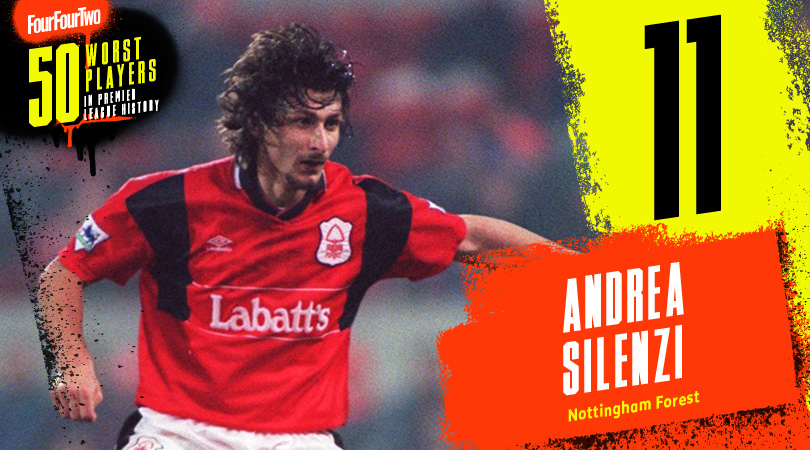
11. Andrea Silenzi
In the mid-1990s, Football Italia had been captivating audiences with the skill of European players, but the first Italian to play in the Premier League had the opposite effect.
Silenzi, signed for £1.8m from Torino in 1995, horrified Nottingham Forest supporters with his leaden touch and laid-back approach. He managed just a handful of appearances and two goals in the FA Cup before Forest cut their losses and loaned him back to Italy. When Forest boss Dave Bassett tried to recall him, Silenzi refused to come back.
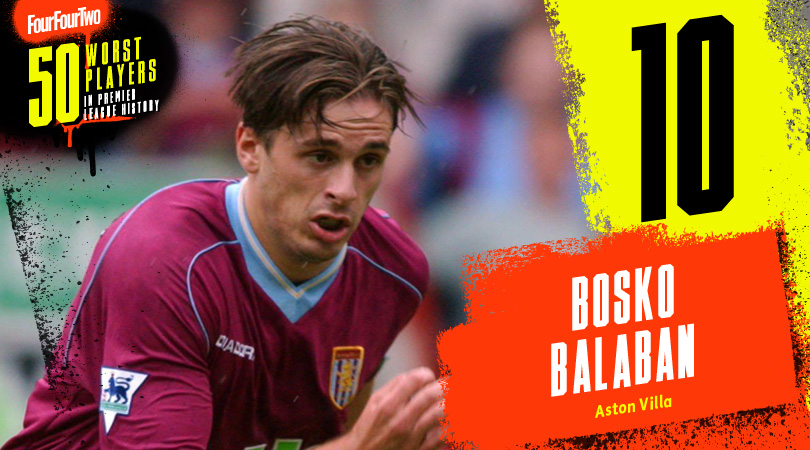
10. Bosko Balaban
The Croatian had been Dinamo Zagreb’s top scorer for two years running when he signed for Aston Villa back in 2001, in a £5.8m, £20,000-a-week deal. His time in Birmingham was a disaster – the striker made just two starts and seven substitute appearances over two-and-a-half years, failing to score.
Weirdly, the drought ended as soon as he left Villa. Balaban scored 15 in 24 when loaned back to Zagreb, and was positively prolific after joining Brugge on a free transfer, netting 25 goals in 24 games in his first season, then 27 in 30 in his second.
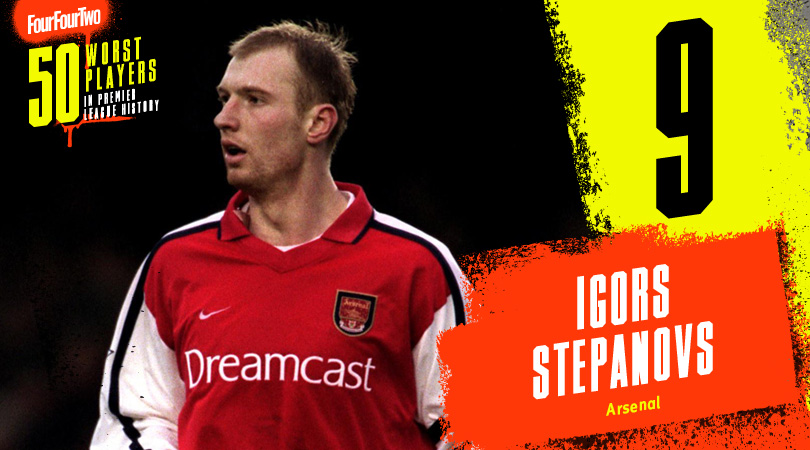
9. Igors Stepanovs
If Marian Pahars was the Latvian Michael Owen, then Stepanovs was probably the Latvian Titus Bramble. Panic-bought from Skonto Riga by Arsene Wenger in 2000 after an injury to Tony Adams, Stepanovs’ English career started well – he scored on his debut, and saw his playing time gradually increase until an infamous game against Manchester United.
A Stepanovs-Gilles Grimandi centre-back pairing was no match for Dwight Yorke, who smashed in a 21-minute hat-trick. United were 5-1 up at half-time, and won 6-1 with the Latvian culpable for at least two of the goals.
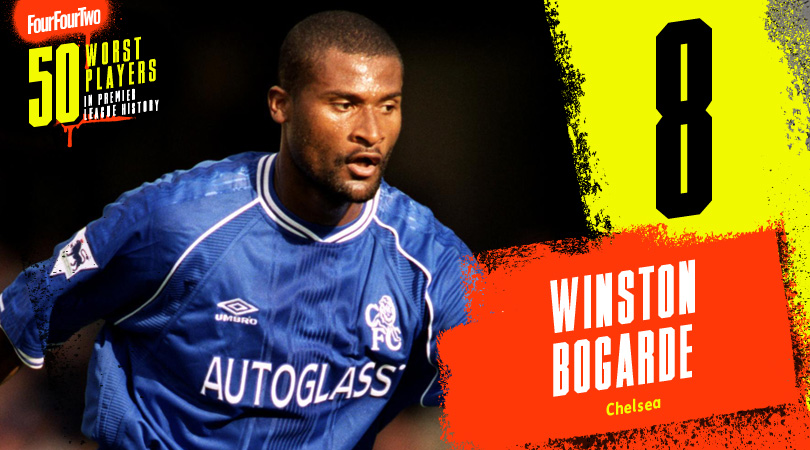
8. Winston Bogarde
The Dutchman had enjoyed an illustrious playing career by the time he joined Chelsea, with spells at Ajax, Milan and Barcelona on his CV. Perhaps that’s what convinced the Blues to give him such a lucrative contract in the summer of 2000 – but Bogarde’s hopes of making an impact at Stamford Bridge were over before they had begun.
Manager Claudio Ranieri had no interest in the player, who nonetheless opted to stay with Chelsea and see out his £40,000-a-week contract instead of trying to find football elsewhere. "Why should I throw €15m away when it's already mine? At the moment I signed it was in fact my money, my contract,” he wrote later.
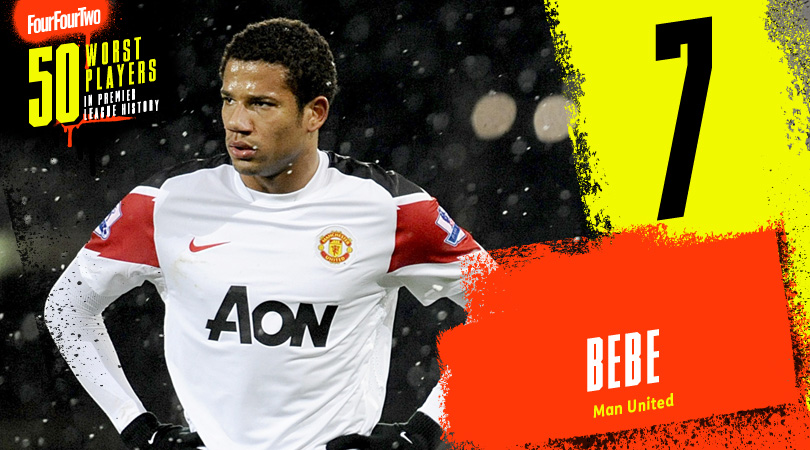
7. Bebe
One of the more baffling transfers in English football history, the arrival of Bebe at Manchester United for a reported £7.4m in 2010 was greeted with widespread confusion – especially when the normally meticulous Alex Ferguson admitted to having never seen him play. It emerged shortly afterwards that super-agent Jorge Mendes had just signed him as a client, which we're sure was just a reaction to the player's sudden elevation.
The Portuguese forward made seven appearances for United in his first season and generally equipped himself with the effort and lack of finesse of a competition winner. The remainder of his United career was spent out on loan, before he was sold to Benfica.
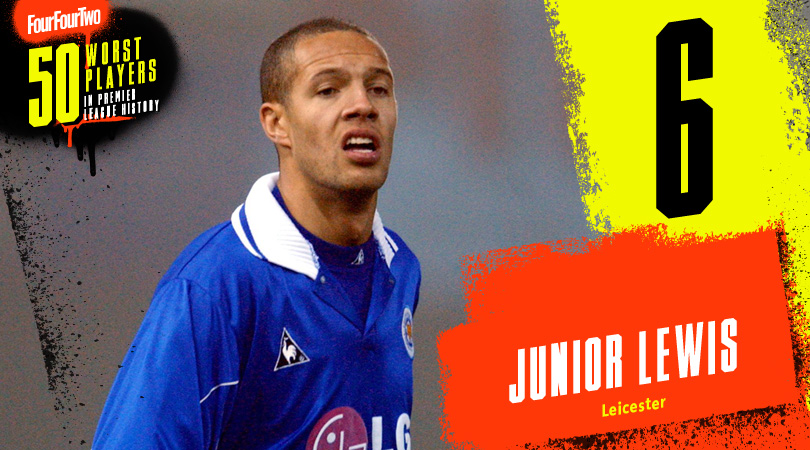
6. Junior Lewis
The bumbling midfielder was voted Leicester’s worst ever player by fans in a FourFourTwo poll, with Foxes fan James Sharpe citing his “incredible ability of being 6ft 2in standing height, and 5ft 8in when jumping”. That he was also named Stevenage’s worst-ever player in the same survey says it all.
Lewis made 30 appearances for Leicester in a three-year spell, and seems to owe much of his career to Peter Taylor, who took him to Filbert Street for £150,000 – one of six times he signed Lewis during his career, including when the player left Leicester on a free.
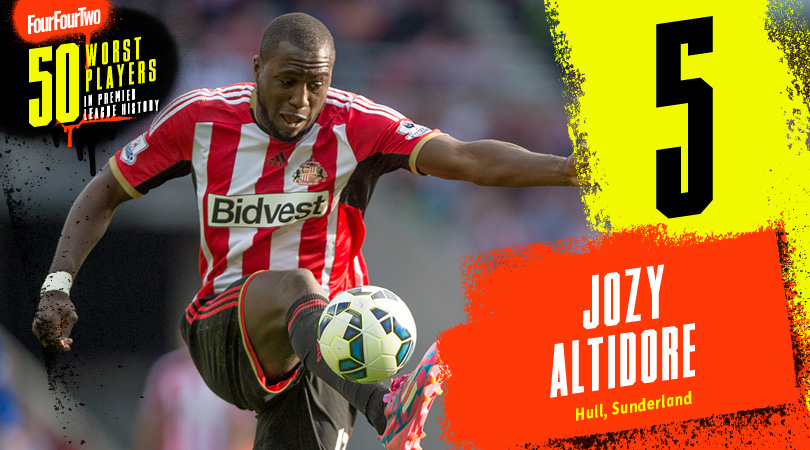
5. Jozy Altidore
The numbers don’t look good for Altidore. The American striker played 70 league games in English football across two spells with relegation strugglers Hull and Sunderland. He scored only two goals. He was strong, quick and could hold the ball up – but it all seemed to fall woefully apart when he had a chance to score.
However, things have picked up since he left Sunderland in 2015. His record for MLS side Toronto Rapids is a prolific 60 goals in 114 games and counting.
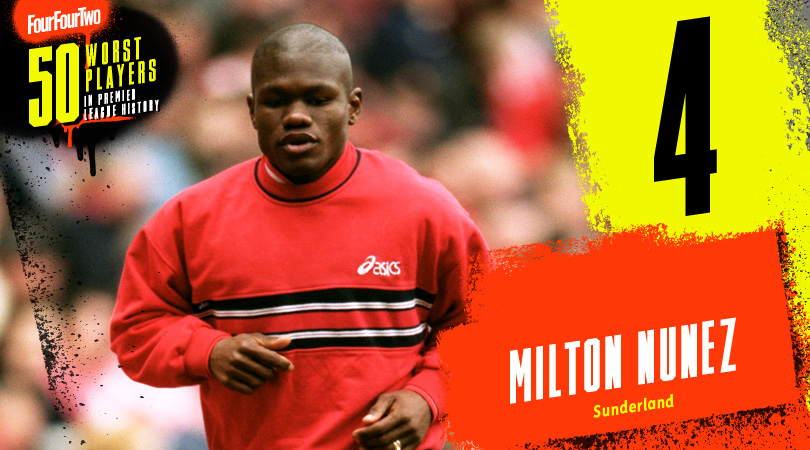
4. Milton Nunez
An air of mystery still surrounds the arrival of diminutive striker Nunez at Sunderland. Signed by Peter Reid for £1.6m on deadline day in 2000, the Honduran made just one appearance for the Black Cats, and it’s been rumoured that Sunderland actually signed the wrong player.
Nunez had been playing for PAOK in Greece, alongside the (much taller) Colombia striker Adolfo Valencia, who legend has it is the person Reid was actually after. Nunez himself has given contradictory versions – in a 2016 interview, he said he was absolutely the player Sunderland wanted to sign, but in 2017 told a Honduran newspaper that the rumours were true.
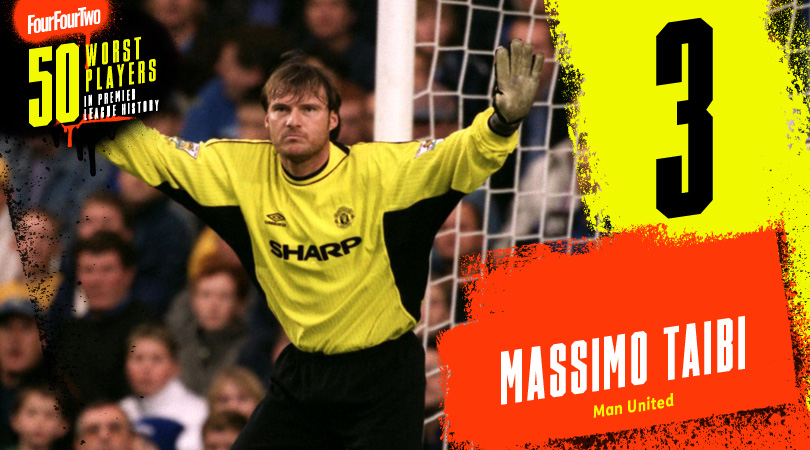
3. Massimo Taibi
According to the Manchester Evening News, Ferguson signed Taibi over Francesco Toldo on the recommendation of his brother Martin, despite the fact the player spoke no English. A local Italian restaurant owner was enlisted to translate instructions from the side of the pitch, and Taibi’s United career actually started pretty well, with a man-of-the-match performance in a 3-2 win over Chelsea.
The Italian wasn’t registered in time to play in Europe, a break in continuity which he blames for an infamous error against Southampton. With the Reds 2-1 up, he let a low shot from Matt Le Tissier dribble through his legs and into the net, effectively ending his United career.
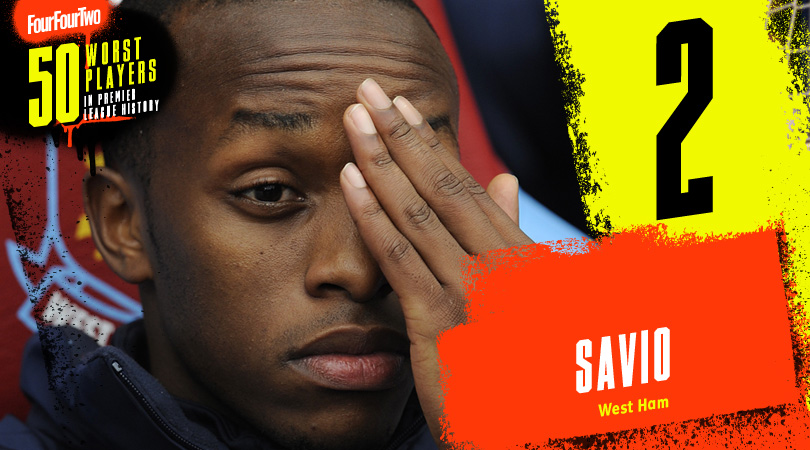
2. Savio Nsereko
West Ham sold Craig Bellamy to Manchester City for £14m in January 2009, and replaced him with a player who’d scored three senior goals in 22 games for Serie B side Brescia – for a reported £9m.
Ugandan-born German Savio had been named player of the tournament at the Under-19 Euros, but struggled to adjust to Premier League football, which seemed to be too physical for his slight stature. He was sold to Fiorentina just 10 league games and six months later for £3m – a huge loss that was later the subject of an internal investigation.
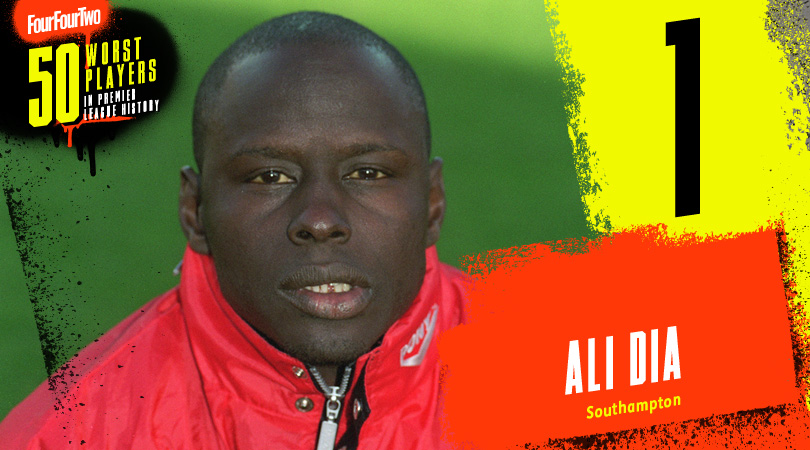
1. Ali Dia
This story remains ridiculous, no matter how many times you hear it, and it’s indicative of how some of the country’s biggest football clubs were still being run with the professionalism and rigour of your local Sunday League team, well into the Premier League era.
Apparently, Dia had been calling round a number of clubs claiming to be George Weah’s cousin in 1995, with Coventry and Bournemouth among those to turn him down after seeing him play.
But Southampton boss Graeme Souness took the bait, and after an early injury to Matt Le Tissier he threw Dia into action against Leeds. The Senegalese forward managed 52 minutes of running around aimlessly before being hauled off again. He was promptly released.

Greg Lea is a freelance football journalist who's filled in wherever FourFourTwo needs him since 2014. He became a Crystal Palace fan after watching a 1-0 loss to Port Vale in 1998, and once got on the scoresheet in a primary school game against Wilfried Zaha's Whitehorse Manor (an own goal in an 8-0 defeat).
